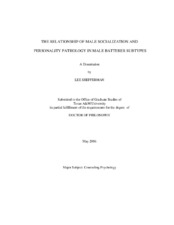| dc.description.abstract | This study examined the role that rigid sex-role stereotyping and male
socialization played in differentiating the three typologies of male batterers. The first
purpose was to utilize a cluster analysis to determine whether the three male batterer
clusters (Family Only (FO), Borderline-Dysphoric (BD) and Generally Violent-
Antisocial (GVA)) theorized by Holtzworth-Munroe and Stuart (1994) could be
reproduced using the MMPI-2. 101 adult court referred males on probation for domestic
violence were given the MMPI-2, and three distinct batterer typologies emerged. Once
the clusters were established, this study attempted to determine if the theoretical model
proposed by Jennings and Murphy (2000), which emphasized male socialization and its
potential effect on male-female interactions within intimate relationships, is influential in
creating differentiation among the cluster typologies. Specifically, an emphasis was
placed on examining how the FO male batterer cluster differed from the BD and GVA
clusters. Four variables were theorized to best represent Jennings and Murphy'™s (2000)
model, including: the Masculine-Feminine (MF) clinical scale, Social Introversion (Si)
clinical scale, Gender-Masculine (GM) supplementary scale and Low Self-Esteem (LSE) content scale. A MANOVA was utilized to see if the three batterer typologies differed
on the variables (MF, Si, GM, and LSE) that encompass the male socialization construct.
Results indicated that statistically significant differentiation did exist between the three
clusters. Furthermore, there was indication that the FO men adhered more closely to
rigid traditional male roles and displayed higher self-esteem. Discussion focused on the
importance of matching treatment to batterer typology and the importance of
incorporating discussion of male socialization into group therapy treatment. | en |


